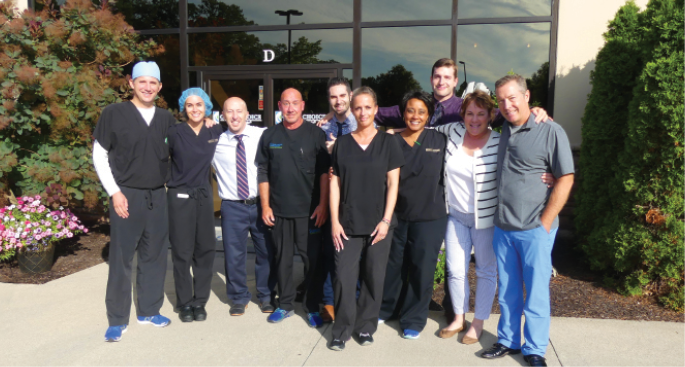
Comanagement has been a buzzword used for many years to describe the relationship between a surgeon ophthalmologist and a nonsurgeon optometrist who share in the responsibilities of pre- and postoperative patient care. There are many successful MD/OD models, some of which are showcased elsewhere in this issue, but from my perspective and more than 20 years of experience as an optometrist, I find that, in order to achieve optimal patient care and to sustain a rise in efficiency and productivity, comanagement must extend well beyond the optometrist and ophthalmologist.
CONSIDER IT A SYSTEM
Today, comanagement must be viewed as a system of eye care that involves many team members, multiple patient-staff interactions, and, often, several different offices. Each patient-staff interaction can be defined as a moment of authenticity in which the quality of care that your system provides is quantified. The team—which includes all of the office and surgery staff personnel as well as those who work under the related systems of integrated high-tech equipment, electronic financial and patient records, phone services, marketing and social media, and the coordinated system of care—is a natural extension of the MD/OD relationship.
The most important aspects of the entire system are the staff members who interact with the patient; they put the warmth in the overall system. In our practice at Clear Choice Custom LASIK in Ohio, we have transitioned away from thinking of comanagement as the MD/OD relationship to an understanding that comanagement refers to our entire system of well-planned, integrated eye care. All team members work together as a united front; this system ensures that the patient is receiving premium care.
DEVELOPING A COORDINATED SYSTEM OF CARE
When a coordinated system of care is implemented, several advantages materialize.

No. 1: First and foremost, each member of the team can serve a specific purpose and is empowered to act as an expert in his or her own role. Each staff member must learn his or her role—and, specifically how his or her individual interactions affect the team and the system of care—but must also be well aware of the corporate DNA. Strategic employee education and cross-training is helpful to guarantee that each patient will have meaningful coordinated interactions with any team member he or she comes into contact with. An important point to remember is that all team members are swimming in the same pond. One poorly integrated fish can damage the pond and make for an unpleasant or even dangerous experience.
At each patient-staff interaction, the entire team and the entire system are being tested and judged. In my optometric role, I am the team leader and advisor, and one of my roles is to ensure that our message to patients is clearly delivered and that our quality of care is consistently good.
I also have the important task of patient examination and communication, which extends to discussions concerning realistic vision objectives. The number of surgical options for refractive and cataract surgery has exponentially increased, and this can often lead to confusing discussions with patients. All team members must be well versed in the options. If cataract surgery is indicated, IOL options must be carefully explained with appropriate documentation. The conversation that I initiate with the patient will guide staff members to expand the discussion to the specific details of the chosen procedure and finance arrangements. After preoperative diagnostics are performed by technical staff members, the patient comes back to me so that I can answer any remaining questions as I detail the surgical experience step by step.

No. 2: The surgery day goes more smoothly. On the day of surgery, patients are already prepped mentally by me, the counselors, and the rest of the team (Figure). They fully understand the particular procedure they are undergoing. After a quick meet-and-greet with the ophthalmology staff, who confirm goals and answer any questions on the risks and benefits of surgery, the numbers and technical data are double-checked. After surgery, the postoperative care staff gives positive feedback and reassurance and provides detailed postoperative instructions. The surgeon also visits patients before they are discharged to answer any questions they might have about the procedure and to reassure them that surgery went well.

Figure. Dr. Augustine (far right) with other Clear Choice Custom LASIK team members.

No. 3: Surgeons maximize their time in the OR, and optometrists maximize their time clinically caring for patients. Time studies and analysis help to improve the integrated system of eye care so that the surgeons can maximize their time in the OR and the optometrists can maximize their time serving on the front line of clinical patient care. For obvious reasons, this boosts practice efficiency and emphasizes the importance of expert, individualized patient care.

No. 4: Patients with complications can be seen more quickly and efficiently. Surgery, by its very nature, is never a sure thing or a guaranteed slam-dunk. Patients who experience an adverse event during surgery or in the follow-up period can be seen more quickly in the integrated system of care. The patient in this system can be managed more efficiently and effectively. When a complication has occurred during surgery, the surgeon discusses that verbally with the patient and optometrist (and notes it in the patient chart postoperatively), so that the patient receives the proper care and attention postoperatively. When a complication occurs postoperatively, that same line of communication between all team members is just as important: The optometrist explains to the ophthalmologist what has happened and, through discussion, the proper plan of action is confirmed.

No. 5: A team approach can help to bolster external marketing. The day after surgery at Clear Choice, I as the optometrist perform the follow-up evaluation. It is important to make this visit a celebration day, when we reinforce the patient experience and empower the patient to celebrate his or her results. In return, the patient is more likely to share his or her experience with friends and family. We have found that our team approach helps us to develop a more efficient external marketing strategy through this word-of-mouth publicity.
START SMALL
Developing a team approach to patient care begins with incremental changes that resonate with the entire organization. It is built on a foundation of trust and mutual respect, which is earned over time and enhanced through planned team education. The entire team must be empowered to think critically about potential surgery options for patients; all must understand the surgical procedures offered at the practice, the perioperative issues that patients may face, and the postoperative issues and complications that will, hopefully rarely, have to be effectively and efficiently addressed.
It takes effort to establish clear lines of communication within the team. System-wide communication must be maintained so that the whole staff uses the same language, messaging, and strategies when talking to patients. When everyone has a distinct understanding of the internal system matrix, then practice efficiency and patient care will improve, and your patient experience will become second to none.




